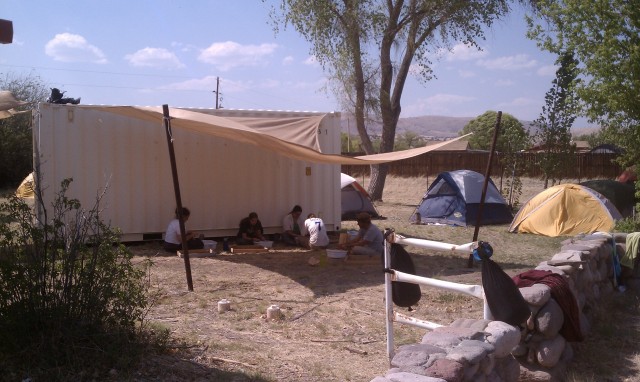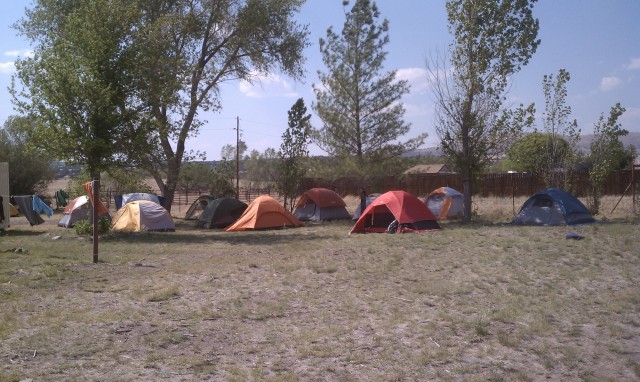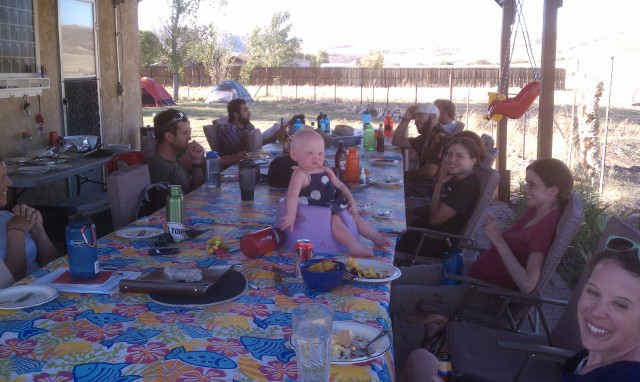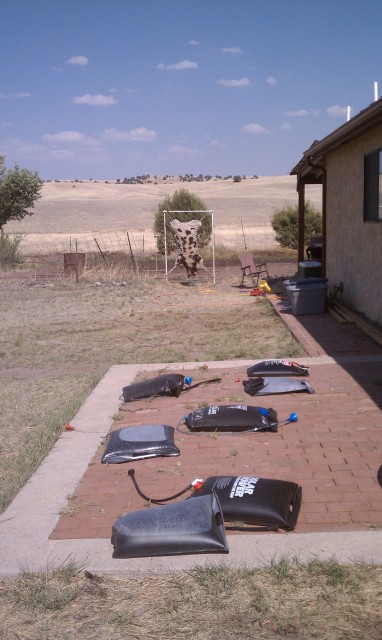- Home
- >
- Preservation Archaeology Blog
- >
- Camp Life

We get out on the site only a little after sunrise and make it back in the late afternoon, which is often taken up with artifact washing, lecture, and the business of trying to get the New Mexico silt scrubbed off. The field house is for cooking, reading, and getting out of the rain (if we had any), so most of the time is spent on the porch. We eat breakfasts and dinners outside at our plywood table, 23 feet and 3 inches long (we measured). In our minimal free time, we have so far played some horseshoes, invented a kind of cross-country bocce ball game, and done a bit of reading. The student’s tents form a little village in the back yard, and a lot of us tuck in early, to be ready for an early start. As I write this, a few stragglers are sitting around the massive table, reading and writing letters home. The porch is a little island of light in an otherwise black sea. So far away from city lights and so thinly populated, Mule Creek nights are dark. But in the morning the coffee gets brewed up again, so we reconvene, bleary eyed, and get ready for another day. Camp is starting to feel like home. Here are some pictures.



2 thoughts on “Camp Life”
Comments are closed.
Explore the News
-
Join Today
Keep up with the latest discoveries in southwestern archaeology. Join today, and receive Archaeology Southwest Magazine, among other member benefits.
I had the opportunity to visit the field school last weekend to give a lecture and get acquainted with staff and students. I also toured Fornholt, the Tularosa phase site we are testing. It was wonderful to leave the heat and hectic pace of Tucson for serene and somewhat cooler Mule Creek.
On the way up I could see the Wallow Fire burning in the distance. It looked like a volcanic eruption with a massive plume and cloud that seemed out of place in an otherwise blue sky. Fortunately for us it is far to the north and the smoke is blowing northwest. Not so fortunate for the inhabitants of Santa Fe and Albuquerque. Although it is extremely dry in Mule Creek, no fires are burning in the vicinity and the air is smoke-free.
We have a wonderful group of students from all over the country. In addition to our Arizona staff, Arkansas, California, Michigan, New Jersey, New York, Texas, Vermont, and Virginia are represented.
After my talk we all settled down on the sofas of the cozy living room in the ranch house. Some people were chatting, some were playing with Rob and Lizzie’s baby, some were reading novels, and some were actually talking about their field notes-one big happy family.
We have made good progress at the site during the initial week despite getting the camp set up and orientation. Much of the time has been spent clearing masonry wall fall. I think we are moving more rocks than dirt at this stage. Our units in the plaza/kiva are designed to figure out how the entry was built as well as other aspects of its construction. We also have a large unit in one of the alleged two-story rooms where we have either found a massive roof or the second story floor. Looks like a lot of burning occurred when the site was depopulated. Can’t wait to see what the kids have found next week when I visit again.
I followed the train of guests last weekend, taking #1 son Avery along to escape the Tucson heat. Katherine Dungan gave a very informative tour of Fornholt. I was impressed by the amounts of burned maize and beans emerging from the unit on the southwest corner of the kiva/plaza. We all wonder what happened there. After an evening talk, of sorts, and some refreshment, the crew brought out Karaoke. Next time I’ll be better prepared — not being the sort who even has heard an entire Britney Spears tune makes it difficult to step into the ring, but perhaps some Marty Robbins. Rob Jones gave us excellent instructions to the Mule Creek obsidian source, and Avery and I gathered up a bunch to bring home and share.